Roger Cooper’s fascinating life story is beautifully manifested through his “Rogerland” garden in East Arlington
STORY BY BENJAMIN LERNER
PHOTOGRAPHY CRAIG LIGHT
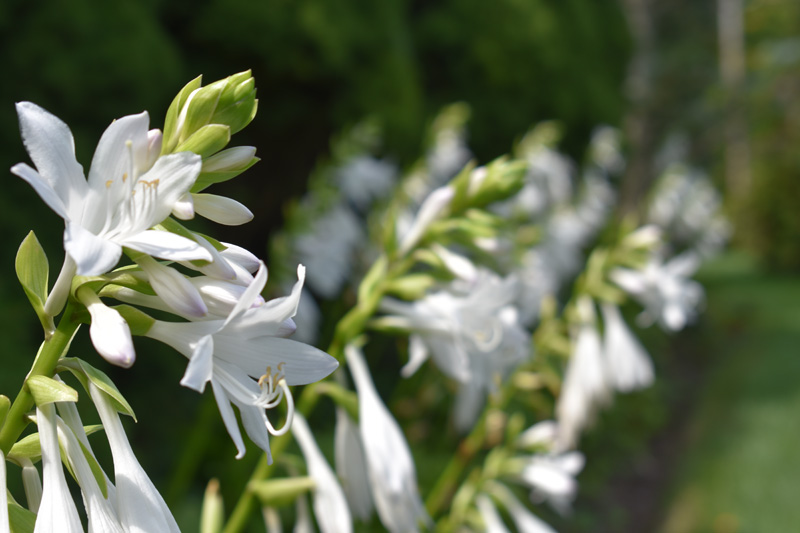
South of Manchester in the heart of East Arlington, a beguiling formal garden known as “Rogerland” stands just down the road from the picturesque Chiselville Bridge. An eclectic assortment of topiaries, raised bed vegetable gardens, fountains, fruit trees, and eye-catching structures form a compelling visual narrative over its verdurous expanses. The trumpet vines and ewe hedges that border the front entrance beckon curious guests to explore the grounds, revel in the splendid beauty of nature, enjoy a spirited round of lawn bowling, or test their golf skills at the on-site putting and chipping green.
Though the gardens possess an undeniable air of storybook serenity, their design is equally as complex as the career and exploits of their eponymous owner, Roger Cooper. A longtime resident of East Arlington, Cooper’s career has encompassed a broad array of scientific, artistic, and professional disciplines. The seemingly divergent aspects of his multifaceted life journey are beautifully expressed in many features of the glorious garden. Cooper designed and built Rogerland with the help of a dedicated team of groundskeepers, artisan craftspeople, and landscape architects. The results are truly remarkable – as is the story of the man who masterminded the sensational sanctuary himself.
The Tale Behind the Topiaries
Much like the origins of the plants, trees, and flowers in his magnificent garden, Roger Cooper’s educational, professional, philanthropic, and artistic adventures have spanned the entire globe. Born and raised in Mexico by English parents, Cooper attended traditional English boarding school, and he completed two separate stints of compulsory military service in both England and Mexico. He went on to graduate from Universidad Iberoamericana in Mexico City with a Bachelor of Science degree in chemical engineering, and earned two additional Bachelor of Science degrees in chemistry and physics from United States University in San Diego.
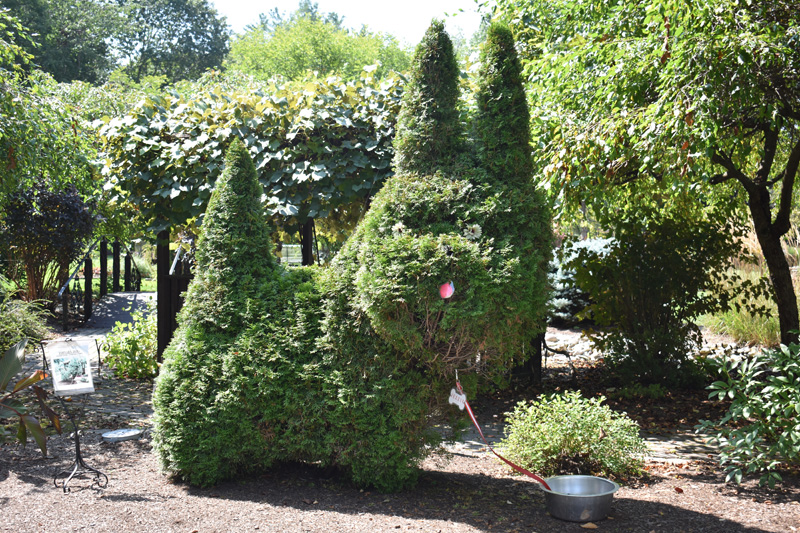
Upon graduating, Cooper began his career as a research chemist at Procter & Gamble in Mexico City. While there, he worked to develop enduring and successful commercial products, such as their bestselling “Era” stain-fighting detergent. Several years later, Cooper transitioned into the field of international banking. He spent thirteen years working for Citigroup in Mexico, Guatemala, Honduras, and Venezuela in their operations and technology sector. Through a mixture of intellectual acuity and sheer tenacity, Cooper climbed the ranks from his original position as Citigroup’s Operations Manager of Mexico City to eventually become the Chief of Staff of Citigroup’s Worldwide Technology Group. In 1984, Cooper moved to New Jersey with his first wife, Sandi Cooper, and their two children, Robin and Alex Cooper. After relocating to Stamford, CT in 1989, Cooper left Citigroup for a new opportunity at JPMorgan Chase (then Chase Manhattan Bank). During his tenure at Chase, Cooper was responsible for all of the foreign exchange, money market derivatives, equity investments, and securities trading for every Northern and Southern American country outside of the United States.
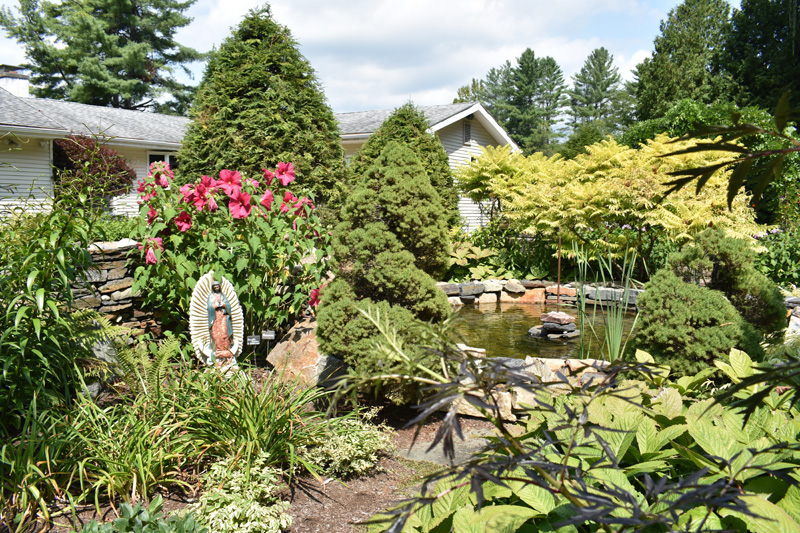
As Roger’s career in finance continued to unfold, he and Sandi purchased a house in Vermont in 1989. “We had taken a trip to Vermont, and we liked the Manchester area,” says Cooper. “It was convenient and relatively close to New York City. It was fun, it had golf courses, skiing, and all of the amenities, especially the tranquility we were looking for.” After purchasing the first house in East Arlington, Cooper eventually bought several surrounding properties, on which the gardens and two houses now stand.
When Sandi and Roger had planted stable roots in southern Vermont, Cooper resumed his studies at SUNY Albany, where he pursued a PhD in linguistic anthropology. “The program specialized in Mayan hieroglyphic text and codices,” says Cooper. After Sandi Cooper tragically passed away, Roger Cooper stepped away from the world of finance. He was not able to complete his dissertation due to Sandi’s medical condition requiring his constant attention in her final days. He then shifted his focus towards his longstanding passion for the theatrical arts. He is now happily married to his second wife, Anne Cooper, whom he had known all his life. “Anne was born on the same day as my sister in the same hospital in Mexico City,” says Cooper. He adds that the connection between their two families dates back to the late-19th century. “Our grandfathers jointly owned a bank back in the late 1800s.” After being put back in touch by Cooper’s sister, Diana, they were married in 2018. They enjoy traveling the world together and spending time relaxing in the garden in Arlington.
Setting the Stage
Cooper first graced the stage in a leading role in an English production of Men in Shadow by Mary Hayley Bell in the 1960s. In the years that followed, he furthered his involvement in stage, television, and film productions in Mexico, Honduras, and Guatemala, including the Oscar-nominated 1976 film, Actas de Marusia. Upon moving to the United States full-time with his family, Cooper became involved with the Emerging Artists Theatre Company (an Off-Broadway company) in the 1990s in New York City as a Finance Chairman of the Board. He continues in the same role today. During that period, he forged a collaborative partnership with another board member, Adam Weinstock. Together, Cooper and Weinstock formed Red Spear Productions, LLC, a production company that has secured 25 Tony® Award nominations and nine Olivier Award nominations to this day. “We’ve been involved with about 20 different Broadway and West End productions, including Back to the Future: The Musical and TINA – The Tina Turner Musical. We have also produced several Off-Broadway shows and films, including Price for Freedom with Navid Negahban and Paul Sorvino. It was about Iran during the time when Ayatollah Khomeini took over. It showed exactly what was going on in those days.”
Origins of the East Arlington Oasis
Roger Cooper and his late first wife, Sandi Cooper, acquired the two houses that span the property where the Rogerland gardens now stand in 1989 and 1991, respectively. When Roger and Sandi purchased the properties, the land was still cluttered with weeds. Over the following decade, Cooper dedicated a significant portion of his time to creating a Southern Vermont garden oasis. “The back was really a hay field before we built the garden,” recalls Cooper. “We started working on the gardens in 1996. The work began with the area by the roadside, and it continued from there.”
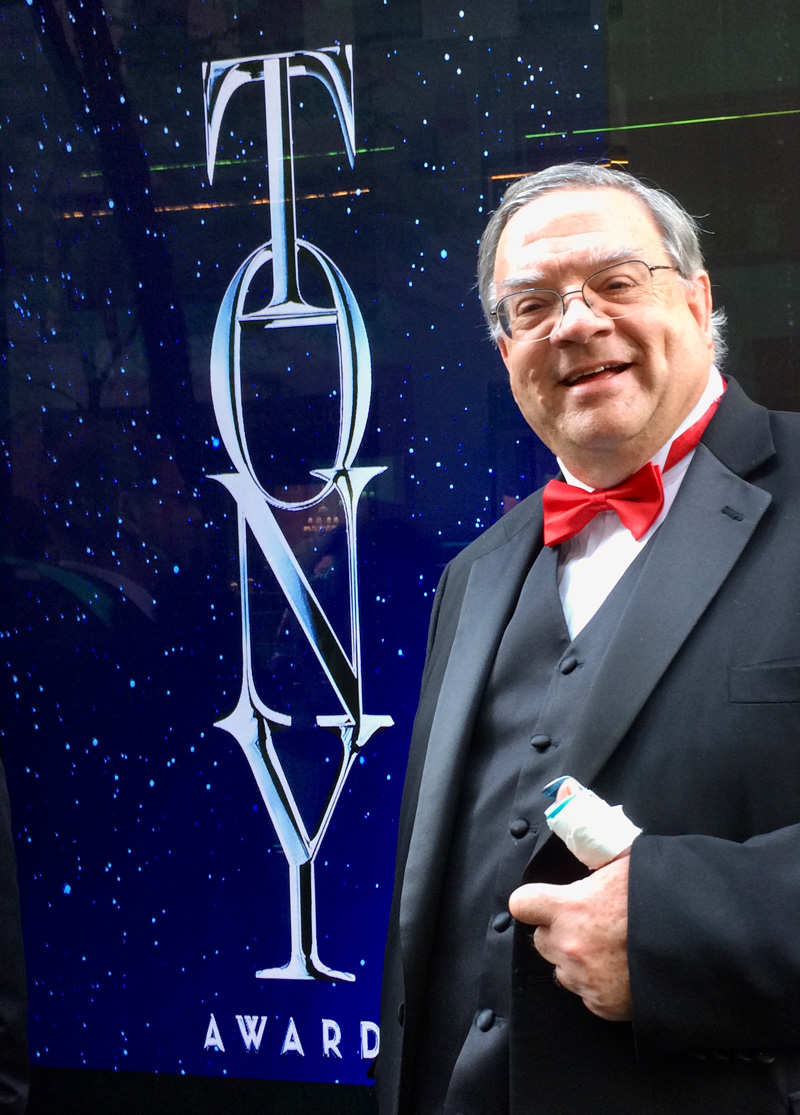
Cooper began designing the concept for the first part of the garden over the winter, which took on many characteristics of a traditional sunken English garden. According to Cooper, the first phase of the Rogerland garden project was focused on infrastructure and planting. “For the initial planting, we brought in 18,000 perennials and 500 trees,” says Cooper. “We had a team that worked full time for a week to plant everything. Before anything came in, we had to prepare the soil, dig ditches, and prepare the water system. There are probably about three or four miles of tubing underneath the garden. There’s a complex water, irrigation, and electrical system and a watering station every fifty feet.”
Today, the garden stands as a mesmerizing, vibrant spectacle of idyllic beauty. During the warmer months, tours are available with advance booking. Individual visitors and groups can enjoy the gardens at their own pace, and a detailed Playbill brochure provides ample information for those who wish to learn more about the garden and the stories behind its most prominent features.
A Transcendental Tour
The tour begins at the main front entrance, which features an enclosed quatrefoil structure within the driveway complete with a Japanese maple tree, a juniper tree, and several spruce trees. Visitors will also notice abundant roses covering the south side of the 1830 farmhouse, which is listed on the National Register of Historic Places. Continuing onward, guests will pass over a brick patio that provides a wonderful view of the surrounding gardens. A copper fountain with ornamental leaves stands catercorner to a waterfall, which feeds into a pond that runs underneath a bridge. The bridge is covered by Dutchman’s pipe vine and Akebia vine, offering a whimsical tribute to the nearby Chiselville covered bridge.
Crossing over the bridge, guests will see a small plot where six varieties of hops are grown for the beer that is made on-site. They will then approach what is referred to as the “Yin-yang pond,” which stands under an oak tree. The pond takes its name from the manner in which it incorporates both tranquility and movement. The relatively still waters of the upper lily pond feed into a sheet fall, which cascades down towards the turbulent waters of the pond below.
While passing the Yin-yang pond, visitors will notice a dual-leveled vegetable garden with solid granite raised beds. A strikingly-elaborate double-helix metal arch built by skilled Vermont metalworker Chaz Perkins stands over a sun-shaped stone. “The helix symbolizes the double helix structure of DNA and the sun—life itself,” notes Cooper. It also represents the years that Cooper spent studying the sciences and his work as a research chemist for Procter & Gamble. A metal fence surrounds the Yin-yang pond, the double helix arch, and the raised granite beds. A second vegetable garden outfitted with split granite raised beds and a raspberry cage is connected by a walkway to the nearby putting green. At the far end of the walkway, an additional metal fence stands with tomatillos and chiles that are perfect for making sauces. “It’s shaped like a plane coming at you,” says Cooper. “The fountain inside of it is made from an old water pump.”
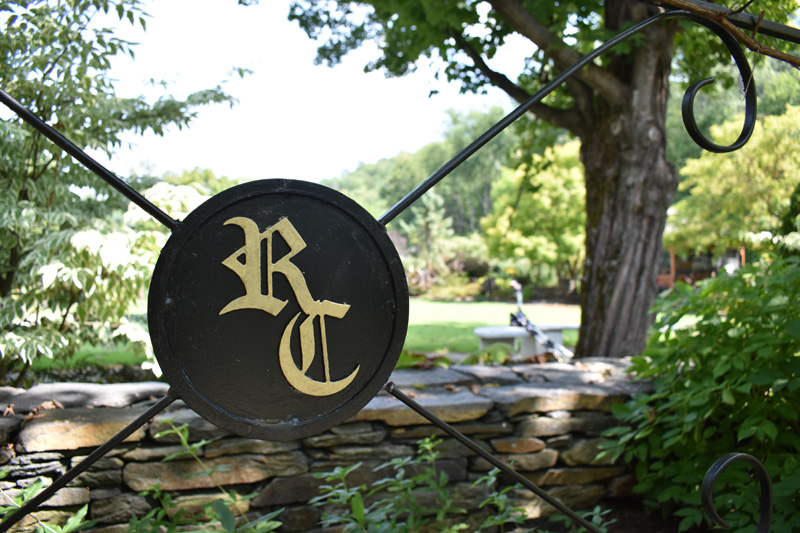
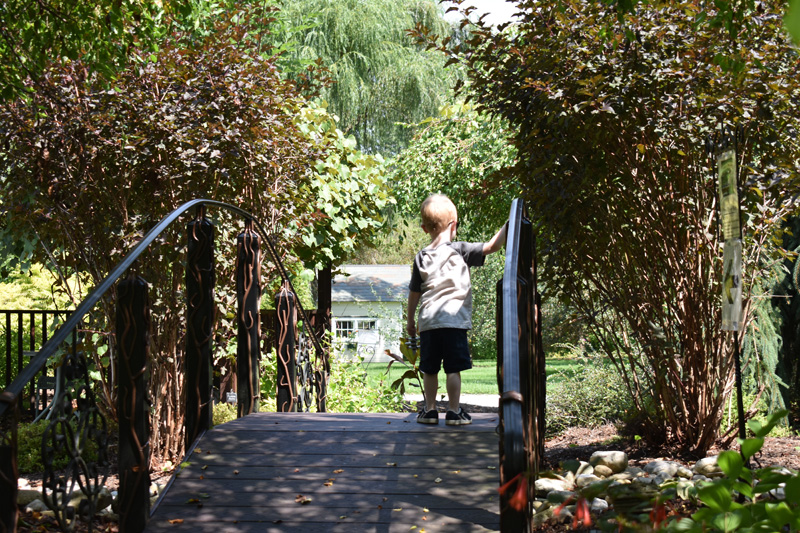
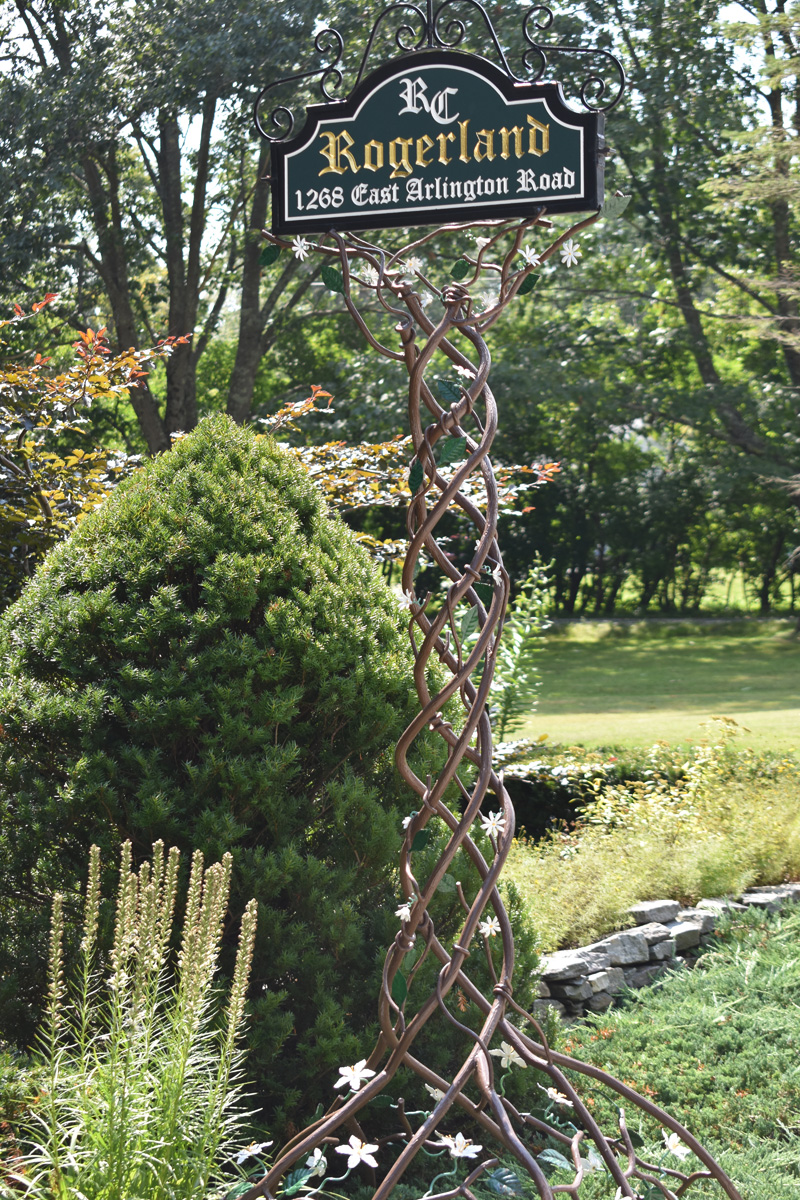
The putting green also features a central fountain that looks like the front of an approaching aircraft. “It’s a 10-foot-high, three-level fountain that dribbles water from one tray to the next.” Cooper says that the inspiration behind the fountains came from the lengthy airplane trips that he regularly took while working as an international finance officer for Citibank and JPMorgan Chase & Co. in Central and South America. “For about 15 years, I would take about five airplane rides a week. Some of them took 10-15 hours at a time.”
Upon completing the walkway, guests will find a topiary carved in the shape of a Saguaro cactus. The shape was chosen as a sentimental nod to the time that Cooper spent in Arizona visiting his son, Alex, his daughter-in-law, Courtney, and their two children, Hailey and Peter. Past the topiary and up a short staircase, a pathway surrounded by hybridized Marquette and Saint Croix grapes leads toward a goddess statue. The grapes are used to produce Vermont-made wine, which is known for its distinctive terroir. Additional plants on either side of the path include Goats-beard, bleeding heart, Barrenwort, Ragwort, and Daylily, among many others. Each plant was chosen with the horticultural health of the grapes in mind, maximizing the efficiency of the small, yet mighty on-site vineyard.
After reaching the goddess statue, guests will turn left, walk through an archway, and come upon the fanciful and quirky “Alice-in-Wonderland Garden.” A life-sized chessboard surrounded by knight-shaped topiaries is complemented by teak chess pieces, which were hand-carved in Indonesia. The black squares on the chess board are made from African “ubatuba” granite, and the white squares are made from Southern Vermont marble from a nearby quarry. An additional plant bed that stands close to the vineyard can be seen from the chess board with vibrant, wavy blue grasses, golden cedar plumes, and a central green head-shaped hedge. The multicolored topiary artfully embodies the spirit of Quetzalcoatl/K’uk’ulkan, the legendary plumed serpent god that went by those two separate names for the Aztec and Maya, respectively. As an avid scholar of Mesoamerican archaeology and Mayan codices, Cooper feels a deep sense of connection to its symbolism.
On either side of the chessboard and gazebo, visitors will find several additional opportunities for outdoor recreation. Those who wish to enjoy a traditional English game of lawn bowling can try their hand at the internationally-celebrated niche sport on one of the few lawn bowling greens in the United States. A painstakingly-executed putting and chipping green stands to the west of the chessboard. The grass is cut thrice weekly with specialized mowers, and two sand traps with the aforementioned three-level fountain between them provide a challenging obstacle for golfers looking to improve their fundamental skills. Dry-laid stone walls around the perimeter stand next to adjoining flower beds, including one which houses an additional homage to Mesoamerican mythology. Three purposely-placed stones represent the “Three Hearthstones of Creation,” the central fire that the ancient Mayans believed served as the crucible of the creation of humanity.
After returning to the Alice-in- Wonderland Garden from the putting green and heading northward through a second arch, visitors will encounter a dry river bed. “The river bed serves as the demarcation line between the formal garden and the ornate English Garden,” notes Cooper. “Sandi wanted a simple Vermont garden, and I wanted an English garden. I think we arrived at a nice compromise.” In the springtime, guests will find glorious pink weeping cherry trees and peonies near the river bed. The graceful trees and tall grasses provide cool shade in the summer, and a picturesque pagoda with honeysuckle and concord grapes growing through the roof serves as a fantastic vantage point for the rest of the garden.
Continuing northward, a double pond with a connecting spillway runs through a courtyard. The upper pond stands next to statues of a boy and girl who are fishing and playing the flute. According to Cooper, the two statues serve as a reminder of his connection with his grandchildren, Hailey and Peter. The bottom pond features spitting frog fountains and a central “golfer” fountain.
Passing by the nearby Garden Annex building, a colorful hydrangea garden stands in front of a variegated willow. Extraordinary red Crocosmia Luficer flowers rest near the edge of the Alpine and rock garden, where four Alberta spruces are juxtaposed by a large Arbovitae and a bench with climbing hydrangea. The bench provides a phenomenal resting point, which is perfect for reflective contemplation in all seasons.
Walking up the steps from the Alpine and rock garden, one will find a large patio with intricate ironwork by Chaz Perkins. Perkins’ flowerboxes were all made on-site, and the views through the “Wisteria” archway are certainly breathtaking. A jaunty stroll down a brick walkway, which is surrounded by astilbe, hemlock, a cedar bush, a Serbian spruce, peonies, and black-eyed Susans, leads to a juniper topiary and a group of “Hildene” peonies. Walking past, guests will lay eyes on the “Gods of Laughter and Sadness” sculpture, a symbolic monument to Cooper’s love of theatre. After passing through the final two archways, a Celtic cross boxwood topiary signals the end of the immersive and breathtaking tour.
Cooper’s Commitment to Community
In addition to planting beautiful perennials and trees in the Rogerland gardens, Cooper has also planted powerful seeds of change through his philanthropic efforts. In an effort to help his developmentally-disabled son, Robin, Cooper played an integral role in the foundation of a Mount Kisco, NY-based nonrpofit, Community Living Corporation (CLC), which provides quality care for disabled adults. “I became Chairman of CLC in 1991 and I’ve been Chairman ever since,” says Cooper. “We started out with just helping 14 people. Today, we service about 2,500 people. We work with seven different affiliated organizations, such as the Epilepsy Foundation of Metropolitan New York, Winslow Therapeutic Riding Center, and others under the ‘CLC Group.’ We also do trust work to help create trusts for disabled people, and we oversee a 40-home residential program in Westchester as well as art education and transportation programs.”
Cooper finds immense fulfillment in his work with CLC. “It’s probably the thing I’m most proud of in my life. There’s a tremendous amount of satisfaction that comes from helping people. It’s always a challenge, it’s always exciting, and I’m constantly involved.” He is also proud of his involvement with the University of New Haven (UNH) in Connecticut. Cooper serves on the Board of Governors, he is a member of the Executive Committee of the Board, and he is also Chairman of the Finance Committee. He received an honorary PhD for his life’s work in the field of Arts and Sciences in May 2019.
Cooper has lent his considerable financial management skillset to help with fundraising efforts for local community programs in Southern Vermont, as well, such as St. James Episcopal Church and Burdett Commons in Arlington. “Burdett Commons was a gathering place for local residents that served the town of Arlington for years,” says Cooper. The project was endorsed by former Vermont Governor, Howard Dean, and former U.S. Congressman Jim Jeffords and former U.S. Senator Patrick Leahy also came down for the event. Cooper adds: “It was a wonderful place that gave both senior citizens and local youth in Arlington a safe place to get together and enjoy healthy community programming.”
In line with the same philosophy of community betterment, Cooper also offers tours of the Rogerland garden at no cost to those who come to visit. “We never charge a penny for it,” says Cooper. “People do have to call in advance to let us know that they are coming, but we just open it up and let people come to enjoy the garden.” The garden is open to the public thanks to the tireless efforts of Rogerland’s knowledgeable Property Manager, Kathy Cotrofeld, who guides and schedules the tours. Some of the tours are scheduled by Bennington Project Independence or the Arlington Garden Club. “When the local clubs come for organized, pre-scheduled tours, we show them around our garden and we often provide them with a complimentary barbecue lunch, as well. We do it to share the tranquility and beauty of the garden with everyone who comes to visit. Our aim is to be a good part of the community and make the gardens accessible. They provide an incredible opportunity for people to truly relax and enjoy the beauty of Southern Vermont.”
ALL THE DETAILS
rogerland.net